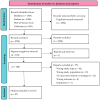Systematic Review: Strategies for Improving HIV Testing and Detection Rates in European Hospitals
- PMID: 38399659
- PMCID: PMC10892502
- DOI: 10.3390/microorganisms12020254
Systematic Review: Strategies for Improving HIV Testing and Detection Rates in European Hospitals
Abstract
Undiagnosed HIV infection is a prominent clinical issue throughout Europe that requires the continuous attention of all healthcare professionals and policymakers to prevent missed testing opportunities and late diagnosis. This systematic review aimed to evaluate interventions to increase HIV testing rates and case detection in European hospitals. Out of 4598 articles identified, 29 studies fulfilled the selection criteria. Most of the studies were conducted in single Western European capital cities, and only one study was from Eastern Europe. The main interventions investigated were test-all and indicator-condition-based testing strategies. Overall, the prevalence of undiagnosed HIV was well above 0.1%. The studied interventions increased the HIV testing rate and the case detection rate. The highest prevalence of undiagnosed HIV was found with the indicator-condition-driven testing strategy, whereas the test-all strategy had the most profound impact on the proportion of late diagnoses. Nevertheless, the HIV testing rates and case-finding varied considerably across studies. In conclusion, effective strategies to promote HIV testing in European hospitals are available, but relevant knowledge gaps regarding generalizability and sustainability remain. These gaps require the promotion of adherence to HIV testing guidelines, as well as additional larger studies representing all European regions.
Keywords: AIDS; Europe; HIV indicator conditions; HIV screening; HIV screening strategies; HIV test strategies; late diagnosis; undiagnosed HIV.
Conflict of interest statement
K.J.V.-J. is conducting a PhD that is supported by investigator-initiated study grants from Gilead Sciences and ViiV Healthcare. C.C.E.J. received travel funding from Gilead Sciences and received speaker funding from ViiV Healthcare, both outside the submitted work. J.I.B. has received honoraria as a speaker from Gilead Sciences, ViiV Healthcare, and Johnson & Johnson outside the submitted work. F.V. reports personal fees, non-financial support from Gilead Sciences and ViiV Healthcare, and grants from MSD and B. Braun Melsungen AG outside the submitted work. A.S.-K. declares no conflicts of interest. O.S. has acted as speaker for Gilead Sciences and Johnson & Johnson, outside of the submitted work. C.R. received funding for investigator-initiated studies from Gilead Sciences and ViiV Healthcare.
Figures
References
-
- European Centre for Disease Prevention and Control (ECDC) WHO Regional Office for Europe . HIV/AIDS Surveillance in Europe 2023 (2022 Data) European Centre for Disease Prevention and Control (ECDC); Stockholm, Sweden: 2023. [(accessed on 21 December 2023)]. Available online: https://www.ecdc.europa.eu/en/publications-data/hivaids-surveillance-eur....
-
- European Centre for Disease Prevention and Control (ECDC) WHO Regional Office for Europe . HIV/AIDS Surveillance in Europe 2022 (2021 Data) European Centre for Disease Prevention and Control (ECDC); Stockholm, Sweden: 2022. [(accessed on 21 December 2023)]. Available online: https://www.ecdc.europa.eu/en/publications-data/hiv-aids-joint-report-su....
-
- UNAIDS UNAIDS Data 2021. 2021. [(accessed on 21 December 2023)]. Available online: https://aidsinfo.unaids.org/
-
- Tominski D., Katchanov J., Driesch D., Daley M.B., Liedtke A., Schneider A., Slevogt H., Arastéh K., Stocker H. The late-presenting HIV-infected patient 30 years after the introduction of HIV testing: Spectrum of opportunistic diseases and missed opportunities for early diagnosis. HIV Med. 2017;18:125–132. doi: 10.1111/hiv.12403. - DOI - PubMed
-
- Marcus J.L., Leyden W.A., Alexeeff S.E., Anderson A.N., Hechter R.C., Hu H., Lam J.O., Towner W.J., Yuan Q., Horberg M.A., et al. Comparison of Overall and Comorbidity-Free Life Expectancy Between Insured Adults With and Without HIV Infection, 2000–2016. JAMA Netw. Open. 2020;3:e207954. doi: 10.1001/jamanetworkopen.2020.7954. - DOI - PMC - PubMed
Publication types
Grants and funding
LinkOut - more resources
Full Text Sources
Medical


